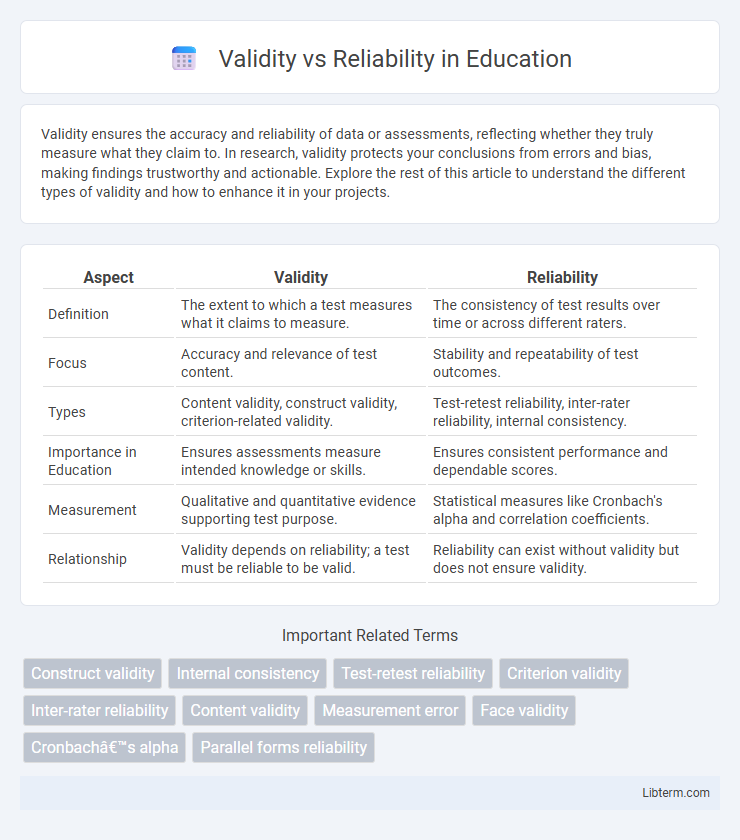Validity ensures the accuracy and reliability of data or assessments, reflecting whether they truly measure what they claim to. In research, validity protects your conclusions from errors and bias, making findings trustworthy and actionable. Explore the rest of this article to understand the different types of validity and how to enhance it in your projects.
Table of Comparison
| Aspect | Validity | Reliability |
|---|---|---|
| Definition | The extent to which a test measures what it claims to measure. | The consistency of test results over time or across different raters. |
| Focus | Accuracy and relevance of test content. | Stability and repeatability of test outcomes. |
| Types | Content validity, construct validity, criterion-related validity. | Test-retest reliability, inter-rater reliability, internal consistency. |
| Importance in Education | Ensures assessments measure intended knowledge or skills. | Ensures consistent performance and dependable scores. |
| Measurement | Qualitative and quantitative evidence supporting test purpose. | Statistical measures like Cronbach's alpha and correlation coefficients. |
| Relationship | Validity depends on reliability; a test must be reliable to be valid. | Reliability can exist without validity but does not ensure validity. |
Understanding Validity and Reliability
Validity measures the accuracy of a test in assessing what it is intended to evaluate, ensuring the results reflect the true concept being studied. Reliability refers to the consistency and stability of measurement results over time or across different observers, indicating the dependability of the data. Understanding validity and reliability is essential for selecting appropriate research methods and interpreting data with confidence in various scientific and educational contexts.
Defining Validity: What Does It Mean?
Validity refers to the extent to which a test or measurement accurately measures what it is intended to measure, ensuring the results truly represent the concept under study. It encompasses various types, including content validity, construct validity, and criterion validity, each addressing specific aspects of measurement accuracy. Establishing validity is crucial for drawing meaningful and trustworthy conclusions from research data or assessments.
Defining Reliability: What Does It Mean?
Reliability refers to the consistency and stability of a measurement or test over time, indicating how dependable the results are when repeated under similar conditions. High reliability means that a test produces similar outcomes across different occasions, raters, or forms, minimizing random errors and enhancing measurement precision. Understanding reliability is crucial for ensuring that data reflects true scores rather than variability caused by external or accidental factors.
Key Differences Between Validity and Reliability
Validity measures how well a test or instrument accurately assesses the specific concept it is intended to measure, ensuring the results are meaningful and relevant. Reliability refers to the consistency and stability of test scores over repeated administrations or different conditions, indicating the dependability of the measurement. Key differences include validity's focus on accuracy and truthfulness of the measurement versus reliability's emphasis on consistency and repeatability of results.
Types of Validity in Research
Types of validity in research include content validity, which ensures the measurement covers the entire scope of the concept; criterion validity, assessing how well one measure predicts an outcome based on another established measure; and construct validity, evaluating whether a test truly measures the theoretical construct it claims to measure. Internal validity addresses whether the study design allows for accurate cause-and-effect conclusions, while external validity relates to the generalizability of the results to other populations or settings. Ensuring high validity strengthens the credibility and applicability of research findings across diverse contexts.
Types of Reliability in Research
Types of reliability in research include test-retest reliability, which measures the consistency of results over time; inter-rater reliability, assessing the agreement between different observers or raters; and internal consistency reliability, evaluating the correlation among multiple items within a single test or instrument. High reliability ensures that research findings are stable and repeatable across different conditions and samples. Understanding these types aids researchers in selecting appropriate methods to enhance measurement precision and minimize errors.
Importance of Validity in Data Collection
Validity ensures that data collection methods accurately measure the intended variables, which is crucial for producing credible research results. High validity in data collection minimizes systematic errors and biases, leading to more trustworthy conclusions. Reliable data without validity can still misrepresent reality, emphasizing that validity holds paramount importance in research accuracy.
Importance of Reliability in Data Analysis
Reliability in data analysis ensures consistent and replicable results, which is crucial for drawing accurate conclusions from repeated measurements or experiments. High reliability reduces random errors and increases the precision of data, strengthening the overall credibility and validity of the research findings. Emphasizing reliability allows analysts to confidently interpret patterns and trends, making it a foundational element in scientific and statistical investigations.
Enhancing Validity and Reliability in Research
Enhancing validity in research involves using accurate measurement tools, employing well-defined operational definitions, and ensuring that the study design appropriately addresses the research questions. Reliability is improved by standardizing procedures, conducting pilot studies to refine instruments, and applying consistent data collection methods to reduce variability. Combining rigorous sampling techniques with thorough training of researchers further strengthens both validity and reliability, leading to more credible and replicable results.
Common Misconceptions about Validity vs Reliability
Validity and reliability are often mistakenly viewed as interchangeable concepts in research methodology, yet they measure fundamentally different aspects; validity assesses whether a test measures what it claims to measure, while reliability evaluates the consistency of the measurement over time. A common misconception is that a reliable test is automatically valid, but high reliability only indicates consistency, not accuracy or truthfulness of the results. Confusing these terms can lead to flawed data interpretation, emphasizing the importance of distinguishing validity as accuracy and reliability as repeatability in scientific studies.
Validity Infographic

 libterm.com
libterm.com